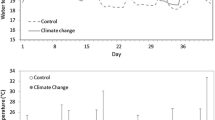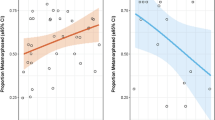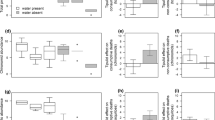Abstract
Populations of the mayfly Cloeon dipterum from 48 ponds (3000 l fibre-glass tanks of 1 m depth) were monitored over the course of 1 year. To simulate possible patterns of climatic change, the ponds were subject to three temperature treatments: continuous heating to 3 °C above ambient; heating to 3 °C above ambient during the summer only; and no heating. Further experimental complexity included enhanced nutrient input into the ponds and the presence or absence of fish, giving a factorial combination of 3 temperature regimes × 2 nutrient levels × presence/absence of fish predation.
Few nymphs were found in the presence of fish. Where fish were absent, the temperature treatments did not significantly affect nymph abundances, and only marginally influenced mean nymph body-lengths. In contrast, the nutrient treatment had significant effects on both nymph abundance and size, with greater numbers of generally larger nymphs occurring in those fish-free ponds receiving additional nutrients. Adult emergence began earlier in the year from the heated ponds, particularly those ponds receiving additional nutrients. Adult body-length differed between temperature treatments, but consistent patterns were difficult to ascertain because of interactions with nutrient treatment and seasonal effects.
Our results show that during the short term at least, elevated temperature as a simulation of climate change does not have an overwhelming influence on either mayfly abundance or size. The influence of temperature is subtle and subject to complex interaction with other habitat variables. We therefore suggest that the direct consequences of small changes in temperature will likely be of little significance to C. dipterum, relative to indirect effects operating through interactions with predation and nutrient input.
Similar content being viewed by others
References
Atkinson, D., 1994. Temperature and organism size-a biological law for ectotherms. Adv. Ecol. Res. 25: 1–58.
Berendonk, T. U., 1999. Influence of fish kairomones on the ovipositing behaviour of Chaoborus imagines. Limnol. Oceanogr. 44: 454–458.
Brittain, J. E., 1982. Biology of mayflies. Ann. Rev. Entomol. 27: 119–147.
Brown, D. S., 1961. The food of the larvae of Chloë on dipterum L. and Baë tis rhodani (Pictet) (Insecta, Ephemeroptera). J. anim. Ecol. 30: 55–75.
Cianciara, S., 1980. Food preference of Cloë on dipterum (L) larvae and dependence of their development and growth on the type of food. Pol. Arch. Hydrobiol. 27: 143–160.
Conway, D., 1998. Recent climate variability and future climate change scenarios for Great Britain. Prog. Phy. Geo. 22: 350–374.
Corkum, L. D., J. J. H. Ciborowski & R. G. Poulin, 1997. Effects of emergence date and maternal size on egg development and sizes of eggs and first-instar nymphs of a semelparous aquatic insect. Oecologia 111: 69–75.
Elliott, J. M. & U. H. Humpesch, 1983. A key to the adults of the British Ephemeroptera. Freshwater Biological Association publication No. 47.
Elliott, J. M., U. H. Humpesch & T. T. Macan, 1988. Larvae of the British Ephemeroptera. Freshwater Biological Association publication No. 49.
Fuller, R. L. & T. J. Fry, 1991. The influence of temperature and food quality on the growth of Hydropsyche betteni (Trichoptera) and Simulium vittatum (Diptera). J. Freshwat. Ecol. 6: 75–86.
Giberson, D. J. & D. M. Rosenberg, 1992. Effects of temperature, food quantity and nymphal rearing density on life-history traits of a northern population of Hexagenia (Ephemeroptera: Ephemeridae). J. n. am. Benthol. Soc. 11: 181–193.
Harker, J. E., 1997. The role of parthenogenesis in the biology of two species of mayfly (Ephemeroptera). Freshwat. Biol. 37: 287–297.
Hogg, I. D. & D. D. Williams, 1996. Response of stream invertebrates to a global-warming thermal regime: an ecosystem-level manipulation. Ecology 77: 395–407.
Houghton, J. T., L. G. Meira, B. A. Callander, N. Harris & K. Maskell, 1996. Climate change 1995: the science of climate change. Cambridge University Press, Cambridge.
Humpesch, U. H., 1981. Effect of temperature on larval growth of Ecdyonurus dispar (Ephemeroptera: Heptageniidae) from two English lakes. Freshwat. Biol. 11: 441–457.
Langford, T. E., 1975. The emergence of insects from a British river warmed by power station cooling-water. II. The emergence patterns of some species of Ephemeroptera, Trichoptera and Megaloptera in relation to water temperature and river flow, upstream and downstream of the cooling water outflows. Hydrobiologia 47: 91–133.
Odum, E. P., 1985. Trends expected in stressed ecosystems. Bioscience 35: 419–422.
Schindler, D. W., 1997. Widespread effects of climatic warming on freshwater ecosystems in North America. Hydrological Processes 11: 1043–1067.
Söderström, O., 1988. Effects of temperature and food quality on life-history parameters in Parameletus chelifer and P. minor (Ephemeroptera): a laboratory study. Freshwat. Biol. 20: 295–303.
Stearns, S. C., 1992. The Evolution of Life Histories. Oxford University Press, New York: 123–149.
Sweeney, B. W. & R. L. Vannote, 1984. Influence of food quality and temperature on life history characteristics of the parthenogenetic mayfly, Cloeon triangulifer. Freshwat. Biol. 14: 621–630.
Sweeney, B. W. & R. L. Vannote, 1986. Growth and production of a stream stonefly: influences of diet and temperature. Ecology 67: 1396–1410.
Vannote, R. L. & B. W. Sweeney, 1980. Geographic analysis of thermal equilibria: a conceptual model for evaluating the effect of natural and modified thermal regimes on aquatic insect communities. Am. Nat. 115: 667–695.
Ward, J. V., 1992. Aquatic insect ecology. 1. Biology and habitat. John Wiley and Sons, Inc: 213–218.
Ward, J. V. & J. A. Stanford, 1982. Thermal responses in the evolutionary ecology of aquatic insects. Ann. Rev. Entomol. 27: 97–117.
Watanabe, N. C., I. Mori & I. Yoshitaka, 1999. Effect of water temperature on the mass emergence of the mayfly, Ephoron shigae, in a Japanese river (Ephemeroptera: Polymitarcyidae). Freshwat. Biol. 41: 537–541.
Author information
Authors and Affiliations
Rights and permissions
About this article
Cite this article
McKee, D., Atkinson, D. The influence of climate change scenarios on populations of the mayfly Cloeon dipterum. Hydrobiologia 441, 55–62 (2000). https://doi.org/10.1023/A:1017595223819
Issue Date:
DOI: https://doi.org/10.1023/A:1017595223819




